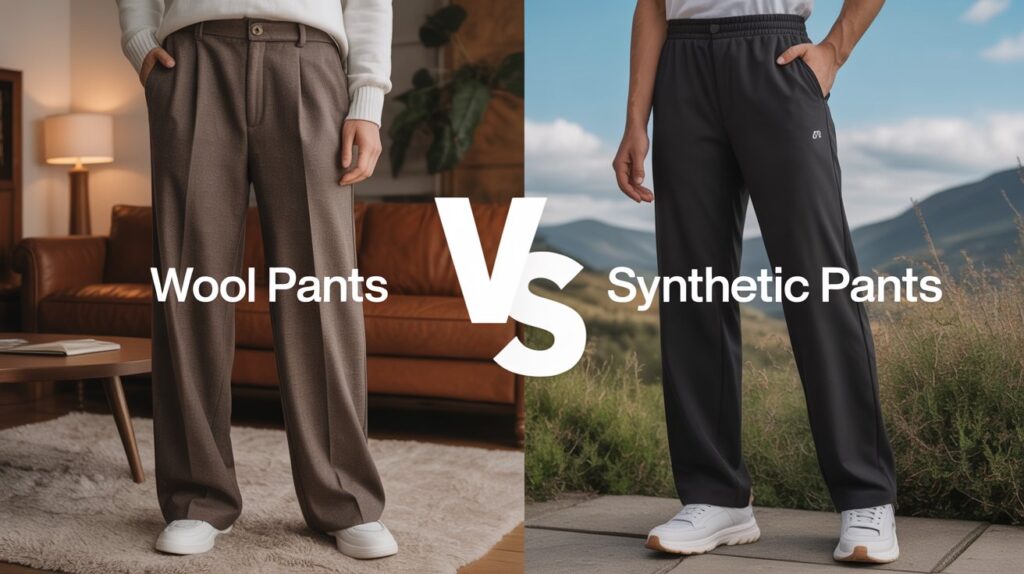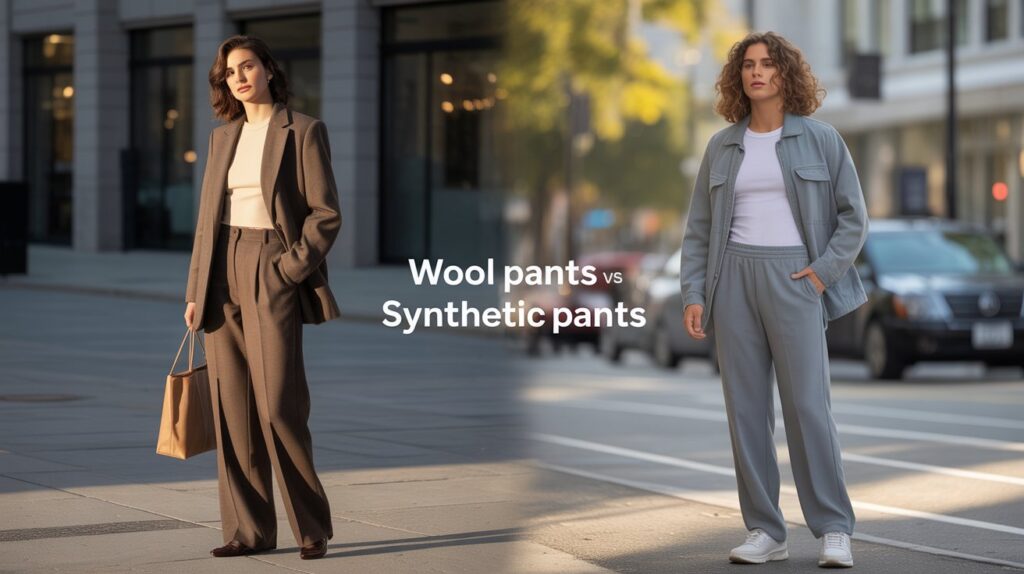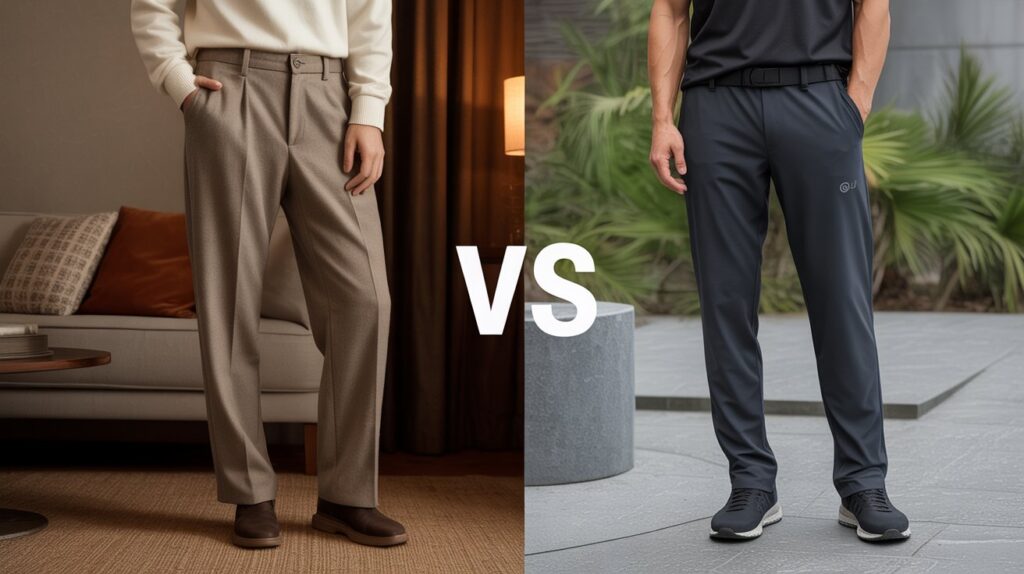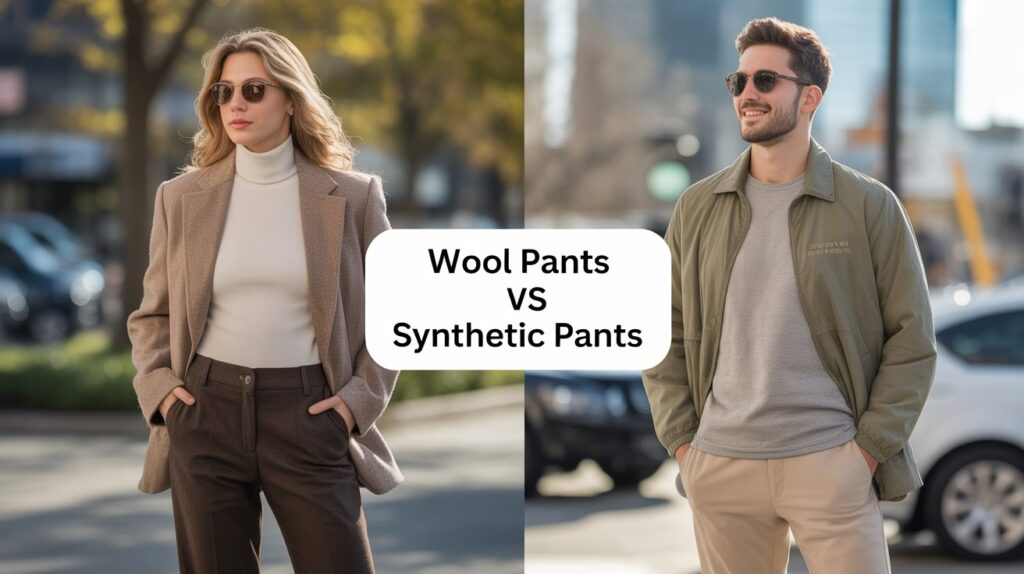
1. Introduction
When it comes to choosing the perfect pair of pants, the debate between wool pants vs synthetic pants is one that many shoppers face. Both materials offer distinct advantages — from comfort and breathability to durability and maintenance — making it essential to understand what sets them apart. In the U.S., where climates vary widely from state to state, selecting the right fabric can make a big difference in how comfortable and stylish you feel year-round.
In this guide, we’ll break down the key differences between wool and synthetic pants, helping you decide which option best fits your lifestyle, climate, and fashion preferences.
Table of Contents
2. Understanding Wool Pants
Wool pants are made from natural fibers derived from sheep, most commonly merino wool, which is highly valued for its softness, breathability, and warmth. Unlike synthetic fabrics, wool is a natural and renewable material that offers excellent comfort across a variety of temperatures — a major reason why wool pants remain popular in both formal and casual wear across the U.S.
What Makes Wool Pants Special
The biggest advantage of wool pants is their temperature-regulating ability. Wool fibers have natural crimp and air pockets that trap heat in cold weather, keeping you warm without feeling bulky. At the same time, these fibers allow air to circulate, which helps prevent overheating. This makes wool pants ideal for colder U.S. states like Colorado, New York, or Michigan, where winter comfort is essential.
Wool also has excellent moisture-wicking properties. It can absorb up to 30% of its weight in moisture without feeling damp, pulling sweat away from your skin and keeping you dry throughout the day. Unlike synthetic fabrics, wool naturally resists odors, meaning you can wear wool pants multiple times before needing a wash — perfect for busy professionals or travelers.
Pros of Wool Pants
- Warmth: Excellent insulation for cold and moderate climates.
- Breathability: Keeps you comfortable indoors and outdoors.
- Odor Resistance: Natural fibers prevent bacterial buildup.
- Eco-Friendly: Renewable, biodegradable, and sustainable material.
- Premium Feel: Luxurious texture and elegant drape, ideal for office or formal wear.
Cons of Wool Pants
- Maintenance: Requires gentle care or dry cleaning to prevent shrinkage.
- Cost: Typically more expensive than synthetic options.
- Sensitivity: Some people may find coarse wool itchy, though merino wool is much softer.
Common Uses in the U.S.
In the United States, wool pants are a go-to choice for winter workwear, business casual outfits, and travel clothing. They are especially favored in regions with cooler climates, as they balance warmth, style, and sophistication. Many U.S. consumers also prefer wool blends — combining wool with nylon or polyester — for added durability and wrinkle resistance.
In short, wool pants are perfect for anyone seeking natural comfort, refined appearance, and dependable warmth. They stand out in the wool pants vs synthetic pants comparison for their superior breathability and timeless quality, making them a smart investment for both everyday wear and professional settings.
3. Understanding Synthetic Pants
Synthetic pants are made from man-made fibers such as polyester, nylon, spandex, or a combination of these materials. Unlike wool, which is a natural fiber, synthetics are engineered fabrics designed to deliver specific performance qualities like durability, stretch, and quick drying. In the wool pants vs synthetic pants debate, synthetic pants are often favored for their affordability, low maintenance, and suitability for active lifestyles.
What Makes Synthetic Pants Popular
The main advantage of synthetic pants is their lightweight and durable nature. These fabrics are resistant to shrinking, wrinkling, and fading — qualities that make them practical for daily use. They also dry much faster than wool, making them ideal for people with busy schedules or for those who love outdoor adventures such as hiking, camping, or traveling across the U.S.
Synthetic materials like polyester and nylon are known for their moisture-wicking and quick-drying abilities, which help keep you comfortable in warmer or humid climates. Many modern synthetic pants also feature stretch fibers like spandex, offering greater mobility and flexibility — perfect for activities such as running errands, exercising, or commuting.
Pros of Synthetic Pants
- Durability: Resistant to wear, tear, and stretching.
- Quick-Drying: Ideal for hot or humid U.S. regions like Florida or Texas.
- Affordable: Generally cheaper than wool pants.
- Wrinkle-Resistant: Maintains a neat look with minimal ironing.
- Versatile: Great for activewear, casual outfits, and travel.
Cons of Synthetic Pants
- Breathability: Less natural airflow compared to wool.
- Odor Retention: Can hold onto sweat smells over time.
- Environmental Impact: Made from petroleum-based materials.
- Comfort: May feel less soft or warm in cold weather.
Common Uses in the U.S.
In the U.S., synthetic pants are extremely popular for athleisure wear, outdoor gear, and budget-friendly fashion. You’ll find them in everything from gym pants and hiking trousers to casual joggers and everyday work pants. Because they’re easy to wash, fast-drying, and wrinkle-resistant, synthetic pants suit the fast-paced lifestyle of many Americans.
In summary, synthetic pants stand out in the wool pants vs synthetic pants comparison for their practicality and performance. They offer unbeatable convenience for active individuals, travelers, and anyone looking for an affordable, low-maintenance option — especially in warmer U.S. climates or for year-round comfort.
4. Wool Pants vs Synthetic Pants: Key Differences
When comparing wool pants vs synthetic pants, the choice often depends on your priorities — whether you value natural comfort, warmth, and luxury, or durability, affordability, and easy care. Both types of pants have their own strengths and weaknesses, and understanding their key differences can help you make the right choice for your wardrobe and lifestyle.
Here’s a clear breakdown of how wool and synthetic pants differ:
| Feature | Wool Pants | Man-made fiber pants |
|---|---|---|
| Material Source | Made from natural wool fibers (usually sheep or merino) | Made from man-made fibers like polyester, nylon, or spandex |
| Warmth | Excellent insulation; ideal for cold climates | Moderate warmth; better for mild to warm weather |
| Breathability | Highly breathable and regulates temperature naturally | Less breathable; can trap heat and moisture |
| Moisture Control | Absorbs and wicks moisture while staying dry to the touch | Quick-drying but may feel clammy against skin |
| Odor Resistance | Naturally resists odor buildup | Can retain odor after sweating |
| Durability | Long-lasting but requires delicate care | Extremely durable and resistant to damage |
| Care | Needs gentle washing or dry cleaning | Easy to machine wash and maintain |
| Price | Usually higher due to natural material and craftsmanship | More affordable and Easily accessible |
| Comfort | Soft, natural, and cozy feel | Lightweight, stretchy, and smooth texture |
| Environmental Impact | Renewable and biodegradable | Made from petroleum; can be less eco-friendly unless recycled |
Detailed Comparison
1. Comfort and Feel:
Wool pants offer a soft, natural warmth that synthetic fabrics struggle to replicate. The fibers adapt to your body temperature, making them comfortable in both cool and moderate conditions. Synthetic pants, on the other hand, are smoother, lighter, and often more flexible — ideal for activities requiring movement, like hiking or travel.
2. Climate Suitability:
In colder U.S. regions, such as Minnesota or Colorado, wool pants perform exceptionally well because of their heat-retaining properties. In contrast, synthetic pants are better suited for warmer or humid states like Florida or California, where breathability and quick drying are more important.
3. Maintenance and Care:
Wool requires more careful handling — often dry cleaning or hand washing — to maintain its texture and shape. Synthetic pants are much easier to care for; they’re machine-washable, quick-drying, and resistant to wrinkles, making them more convenient for everyday wear.
4. Cost and Value:
When it comes to price, wool pants generally cost more upfront due to the quality of natural fibers and craftsmanship. However, they can last for years if properly maintained. Synthetic pants are budget-friendly, offering good value for those who need reliable, low-maintenance options.
5. Environmental Considerations:
Wool is a renewable and biodegradable material, which makes it an eco-friendly choice. Synthetic fabrics are petroleum-based, though some modern brands now use recycled polyester to reduce environmental impact.
In summary, the wool pants vs synthetic pants comparison comes down to your needs:
- Choose wool pants for superior comfort, warmth, and natural quality.
- Choose synthetic pants for affordability, performance, and easy care.
Both have their place in a modern wardrobe — it just depends on your climate, lifestyle, and preferences.
5. Comfort and Climate Suitability in the US
When comparing wool pants vs synthetic pants, comfort and climate suitability play a major role in deciding which material performs best for your lifestyle. The U.S. has diverse weather conditions — from freezing winters in the North to hot, humid summers in the South — so choosing the right fabric can make a big difference in how comfortable you feel year-round.
Comfort Levels
Wool pants are known for their natural softness and breathability, making them highly comfortable to wear for extended periods. The wool fibers trap air to keep you warm in the cold but also allow moisture and heat to escape when temperatures rise. This balance of insulation and ventilation gives wool pants a comfortable, temperature-regulating quality that synthetic materials often lack.
In contrast, synthetic pants are designed for lightweight comfort and flexibility. They often include stretchy materials like spandex or elastane, which provide excellent mobility and a snug fit. However, synthetic fabrics may not breathe as well as wool, which can cause discomfort in hot or humid environments if airflow is limited.
Best Choice by U.S. Climate
- Cold and Dry States (e.g., Colorado, New York, Montana): Wool pants are the ideal choice because they provide superior warmth and insulation. They naturally maintain body heat even in freezing temperatures, making them perfect for winter commutes or outdoor activities.
- Warm or Humid States (e.g., Florida, Texas, California): Synthetic pants perform better here due to their quick-drying and lightweight nature. They wick moisture efficiently and keep you cool during hot days, making them great for travel, exercise, or everyday wear.
- Moderate or Transitional Climates (e.g., North Carolina, Oregon): Both materials can work well. Wool blends (wool mixed with synthetic fibers) offer the best of both worlds — warmth without heaviness and durability without overheating.
Overall Comfort Consideration
If you prioritize softness, breathability, and temperature regulation, wool pants provide unmatched comfort. On the other hand, if you value ease of movement, moisture control, and practicality, synthetic pants are a better fit.
In summary, the choice between wool pants vs synthetic pants depends largely on where you live and how you plan to wear them. Wool offers natural coziness for cooler climates, while synthetics deliver performance and convenience in warmer, active environments — making both materials valuable for different U.S. weather conditions.
6. Style and Versatility
When it comes to style and versatility, both wool and synthetic pants have their strengths, catering to different occasions and fashion preferences. Understanding how each fabric performs in terms of appearance, pairing options, and adaptability helps you decide which is best suited for your lifestyle. In the comparison of wool pants vs synthetic pants, the difference becomes clear when you look at how each material complements various looks and functions.
Wool Pants: Classic Elegance and Timeless Appeal
Wool pants are known for their refined and sophisticated style, making them a top choice for professional, business-casual, and formal settings. The natural drape and texture of wool give these pants a polished appearance that synthetic fabrics often can’t replicate. Whether you’re dressing for a boardroom meeting, a winter event, or a formal dinner, wool pants offer effortless elegance.
- Best for: Business attire, smart-casual looks, and cold-weather layering.
- Styling tips: Pair wool trousers with dress shirts, blazers, or knit sweaters for a sleek, put-together outfit.
- Seasonal versatility: Perfect for fall and winter, but lighter wool blends also work well for spring office wear.
Wool’s adaptability extends beyond formal fashion. Many modern brands offer casual wool-blend pants that combine structure with comfort, allowing you to dress them down with sneakers or loafers for a more relaxed yet stylish look.
Synthetic Pants: Functional and Modern Flexibility
Synthetic pants excel in versatility and practicality, appealing to people with active or on-the-go lifestyles. They are lightweight, wrinkle-resistant, and easy to maintain — ideal for travel, outdoor adventures, or casual everyday wear. Their sleek, modern appearance also makes them a popular choice for contemporary streetwear and athleisure outfits.
- Best for: Outdoor activities, gym wear, travel, and casual fashion.
- Styling tips: Pair synthetic joggers or tapered pants with t-shirts, hoodies, or lightweight jackets for a trendy, sporty vibe.
- Seasonal versatility: Great for spring and summer or anytime you need breathable, quick-drying comfort.
Many U.S. consumers love synthetic pants because they come in a wide variety of colors, fits, and styles, from slim-fit joggers to relaxed hiking pants. This makes them easy to incorporate into different wardrobes without sacrificing comfort or function.
Final Thoughts on Style and Versatility
In the wool pants vs synthetic pants comparison, wool leads in classic style and sophistication, while synthetics dominate in casual versatility and modern functionality. Wool pants are ideal for formal settings and cool-weather fashion, whereas synthetic pants shine in active, relaxed, and warm-weather scenarios.
Ultimately, both materials offer distinct style benefits — the key is to match your pants to your lifestyle and the occasions you dress for.

7. Durability and Maintenance
When comparing wool pants vs synthetic pants, durability and maintenance are two of the most important factors to consider. While both materials can last for years with proper care, they differ significantly in how they handle wear, washing, and long-term performance. Understanding these differences can help you make a smarter, more cost-effective choice based on your lifestyle.
Durability
Wool pants are naturally strong and resilient thanks to the crimped structure of wool fibers. This elasticity allows the fabric to stretch slightly without losing its shape, making it resistant to wrinkles and sagging. However, wool can be susceptible to abrasion and pilling if exposed to frequent friction or rough surfaces. To maintain their elegant look, wool pants are best suited for professional, semi-formal, or moderate use rather than rugged outdoor wear.
On the other hand, synthetic pants are built for high performance and durability. Materials like polyester and nylon are engineered to resist tearing, shrinking, and fading even after multiple washes. This makes synthetic pants ideal for active lifestyles — whether for hiking, sports, or daily errands. They are less likely to wear out quickly, especially when exposed to constant movement or outdoor conditions.
Maintenance and Care
Wool pants require a bit more attention to keep them in good shape. Since wool is a natural fiber, it can shrink or lose texture if washed incorrectly. Most wool garments are dry-clean only or should be hand-washed with cold water and mild detergent. Allow them to dry naturally to help maintain their original shape. With proper care, wool pants can last for many years, maintaining their softness and refined appearance.
Synthetic pants, in contrast, are extremely low-maintenance. They are machine washable, quick-drying, and wrinkle-resistant, making them perfect for people who prefer convenience. You can wash them regularly without worrying about shrinking or fading. However, using too much heat during drying may weaken synthetic fibers over time, so tumble drying on a low setting is best.
Long-Term Performance
In terms of longevity, both materials have their strengths:
- Wool pants last longer when treated carefully, retaining their structure and premium appearance for years.
- Synthetic pants withstand frequent washing and rough use, making them more durable for active or outdoor purposes.
Summary
In the wool pants vs synthetic pants comparison, wool offers durability through natural strength and elasticity but requires mindful care. Synthetic pants excel in resilience and ease of maintenance, offering a more practical option for everyday wear.
If you value long-lasting quality and timeless style, wool pants are worth the investment. But if you prioritize low-maintenance durability and convenience, synthetic pants are the better choice for daily comfort and performance.
8. Cost Comparison
When deciding between wool pants vs synthetic pants, cost is often one of the biggest deciding factors. While both options offer good value for money, the difference in materials, production processes, and long-term performance can make one more economical than the other — depending on your budget and lifestyle.
Price Range and Affordability
Wool pants are generally considered a premium clothing item. They are made from natural fibers that require careful processing, which increases production costs. High-quality wool, such as merino or cashmere blends, can raise the price even further. On average, wool pants in the U.S. range from $80 to $250, depending on the brand and quality.
In contrast, synthetic pants are much more budget-friendly because they’re made from man-made fibers like polyester or nylon, which are inexpensive to produce in large quantities. This makes them widely available and affordable for most consumers. Synthetic pants typically cost between $25 and $90, making them a popular choice for casual wear and active lifestyles.
Long-Term Value
Although wool pants have a higher upfront cost, they can offer better long-term value if properly cared for. Wool is durable, resists odor, and retains its appearance for years without frequent washing. For someone who values longevity and classic style, wool pants can be a worthwhile investment that pays off over time.
On the other hand, synthetic pants may not last as long as premium wool garments, but their low maintenance and lower replacement cost make them an excellent value for people who wear their pants often or engage in active pursuits. They’re easy to clean, quick to dry, and ideal for travel or daily use — saving both time and money on upkeep.
Cost vs Performance
In the wool pants vs synthetic pants debate, it’s important to look beyond price alone. Wool offers exceptional comfort, temperature control, and a refined look — features that justify its higher cost. Synthetic pants, while more affordable, excel in practicality, durability, and convenience, especially for everyday or outdoor wear.
Summary
- Wool Pants: Higher initial cost, but long-lasting and luxurious.
- Synthetic Pants: Budget-friendly, durable, and easy to maintain.
In short, wool pants are a smart choice for those seeking long-term quality and sophistication, while synthetic pants are perfect for anyone who wants affordable, versatile, and low-maintenance clothing for daily use. Your final decision should balance both budget and lifestyle needs to get the best value from either option.

9. Sustainability and Environmental Impact
When comparing wool pants vs synthetic pants, sustainability and environmental impact are important factors that influence many buyers in the U.S. today. As consumers become more eco-conscious, understanding how each fabric affects the planet helps you make a responsible and informed choice.
Wool Pants: Natural and Renewable
Wool pants are made from a natural, renewable resource — sheep’s wool. This makes them a more sustainable option compared to many man-made fabrics. Wool is biodegradable, meaning it breaks down naturally without leaving harmful residues in the environment. When properly sourced, wool production supports rural farming communities and can be maintained without heavy reliance on synthetic chemicals.
However, wool is not entirely without environmental concerns. The carbon footprint of sheep farming, including methane emissions and land use, can contribute to environmental strain if not managed responsibly. Additionally, some wool garments require dry cleaning, which may involve chemical solvents unless eco-friendly methods are used. To reduce impact, consumers can choose ethically sourced or organic wool, certified by organizations such as the Responsible Wool Standard (RWS).
Synthetic Pants: Durable but Resource-Intensive
Synthetic pants, on the other hand, are made from petroleum-based fibers such as polyester and nylon. These materials are not biodegradable and can take hundreds of years to decompose, contributing to long-term waste in landfills. The production of synthetic fabrics also consumes significant energy and water resources, and it can release microplastics into waterways during washing.
On the positive side, many brands in the U.S. are now producing recycled synthetic pants using reclaimed plastic bottles or old garments. This helps reduce waste and lessens dependence on virgin petroleum. Recycled polyester, for example, offers nearly the same durability and performance benefits as traditional synthetics but with a smaller environmental footprint.
Comparing Eco-Friendliness
In the wool pants vs synthetic pants comparison, both fabrics have strengths and weaknesses:
- Wool pants are renewable and biodegradable but rely on animal farming.
- Synthetic pants are durable and versatile but contribute to plastic waste and pollution.
The most sustainable choice often depends on production practices, material sourcing, and how long the garment is worn before being replaced.
How to Choose More Sustainably
- Look for certified sustainable wool (e.g., RWS or ZQ Merino).
- Choose recycled synthetic fabrics instead of virgin polyester or nylon.
- Extend the lifespan of your pants by washing less frequently and repairing when needed.
- Support brands that prioritize ethical manufacturing and eco-conscious materials.
Summary
From an environmental standpoint, wool pants have the advantage of being natural, renewable, and biodegradable, while synthetic pants offer durability but come with a higher ecological cost. In the ongoing debate of wool pants vs synthetic pants, the most sustainable choice is the one made with care — both in how it’s produced and how long you keep it in your wardrobe.
10. Final Verdict: Which Should You Choose?
When it comes to deciding between wool pants vs synthetic pants, the right choice depends on your personal preferences, lifestyle, and the climate you live in. Both materials offer unique advantages — wool stands out for its natural comfort and timeless appeal, while synthetics shine in practicality, affordability, and ease of care.
Choose Wool Pants If:
- You live in a colder region or experience chilly winters.
- You prefer natural, breathable fabrics that regulate temperature.
- You want a polished and sophisticated look for work or formal occasions.
- You value long-term durability and eco-friendliness when properly maintained.
Wool pants are perfect for those who prioritize comfort, warmth, and elegance. Their ability to balance breathability and insulation makes them ideal for professional wear or travel in cooler U.S. climates. Though they require gentle care, the long-lasting quality and refined appearance make them worth the investment.
Choose Synthetic Pants If:
- You live in a warm or humid area where lightweight clothing is essential.
- You need durable, easy-to-maintain pants for everyday use or outdoor activities.
- You prefer a budget-friendly option that dries quickly and resists wrinkles.
- You lead an active or on-the-go lifestyle that demands flexibility and comfort.
Synthetic pants offer unmatched convenience for daily wear. Their resilience and quick-drying nature make them ideal for hiking, traveling, or casual outings. They may not provide the same luxurious feel as wool, but they excel in performance and practicality.
The Bottom Line
In the wool pants vs synthetic pants debate, there isn’t a one-size-fits-all answer — it’s all about matching the material to your needs.
- For style, comfort, and natural warmth → choose wool pants.
- For versatility, durability, and affordability → go with synthetic pants.
Both fabrics have a valuable place in your wardrobe. Owning one of each can give you the flexibility to dress comfortably and appropriately for every season and occasion.

11. Additional Resources / Related Reading
If you found this comparison of wool pants vs synthetic pants helpful, you may also be interested in exploring other fabric comparisons and style guides that can help you make smarter wardrobe decisions. Understanding different materials not only improves your comfort but also helps you choose clothing that fits your lifestyle, climate, and values.
Here are some related resources and guides worth checking out:
1. Wool vs Cotton Pants: Which Is Better for Winter?
Learn how wool and cotton compare in terms of warmth, breathability, and durability. This guide explains why wool remains the top choice for cold-weather wear and how cotton pants can still be stylish and comfortable for mild climates.
2. Polyester Pants vs Cotton Pants: Comfort and Breathability Compared
Discover the key differences between synthetic and natural fabrics when it comes to comfort, airflow, and moisture control. This article helps you understand which material suits your everyday activities and personal preferences.
3. Tailored Pants vs Off-the-Rack Pants: Finding the Perfect Fit
A practical guide to choosing pants that match your body type and style. Learn when it’s worth investing in tailored clothing and when ready-made options might be the smarter choice.
4. How to Care for Wool Clothing the Right Way
Proper care can extend the life of your wool pants and other wool garments. This guide covers washing, drying, and storage tips to keep your clothes looking new for years.
5. Sustainable Fabric Choices: Building an Eco-Friendly Wardrobe
If sustainability matters to you, this resource explores eco-conscious fabric options — from organic wool to recycled polyester — and how they impact the planet.
By exploring these related topics, you’ll gain a deeper understanding of how different fabrics perform and how to build a versatile, climate-appropriate, and sustainable wardrobe. Whether you prefer the natural comfort of wool or the practicality of synthetic materials, staying informed ensures that every clothing choice is both stylish and functional.
Each of these resources complements the insights shared in this wool pants vs synthetic pants guide — helping you make confident, well-informed fashion decisions year-round.
12. conclusion
Choosing between wool pants vs synthetic pants ultimately depends on your lifestyle, climate, and personal preferences. Both fabrics bring their own strengths — wool offers unmatched warmth, natural breathability, and a timeless sense of style, while synthetic pants provide durability, easy maintenance, and affordability.
For those living in colder U.S. regions or seeking classic sophistication, wool pants are the perfect choice. They regulate body temperature, resist odors, and elevate your wardrobe with a refined look. On the other hand, if you prioritize convenience, wrinkle resistance, and versatility for outdoor or everyday wear, synthetic pants are the more practical option.
In the end, there’s no one-size-fits-all answer — the best pick depends on how and where you plan to wear them. By understanding the differences between these two materials, you can confidently choose pants that balance comfort, performance, and sustainability for your unique needs. Whether it’s the natural elegance of wool or the modern efficiency of synthetics, your ideal pair is just a smart choice away.
13. FAQs
Which is better for winter wear — wool pants or synthetic pants?
Wool pants are generally better for winter because they provide superior warmth and natural insulation. The fibers trap body heat while allowing airflow, keeping you warm without overheating. Synthetic pants, while durable and quick-drying, don’t offer the same level of natural warmth, making them better suited for mild or active outdoor use.
Are synthetic pants more durable than wool pants?
Yes, synthetic pants are typically more durable and resistant to tears, wrinkles, and shrinking. They can handle frequent washing and daily wear without losing their shape. Wool pants, however, can last for years if properly cared for — they just require gentler maintenance, such as hand washing or dry cleaning.
Do wool pants require special care?
Yes. Wool pants should be cleaned carefully to maintain their texture and shape. It’s best to hand wash them in cold water with mild detergent or use dry cleaning. Allow them to air dry naturally to retain their structure. Avoid high heat, as it can shrink or damage the fibers.
Which is more eco-friendly — wool pants or synthetic pants?
Wool pants are more eco-friendly because wool is a renewable and biodegradable natural material. However, responsible sourcing is important to reduce environmental impact. Synthetic pants, made from petroleum-based fibers, are less sustainable, but recycled versions made from plastic waste are becoming a greener alternative.
Which should I choose for everyday wear?
If you want comfort, luxury, and natural breathability, wool pants are an excellent choice, especially in cooler climates. If you prefer easy-care, budget-friendly, and lightweight pants for daily use or outdoor activities, synthetic pants are the better option. Ultimately, your choice depends on your climate, wardrobe needs, and lifestyle.
